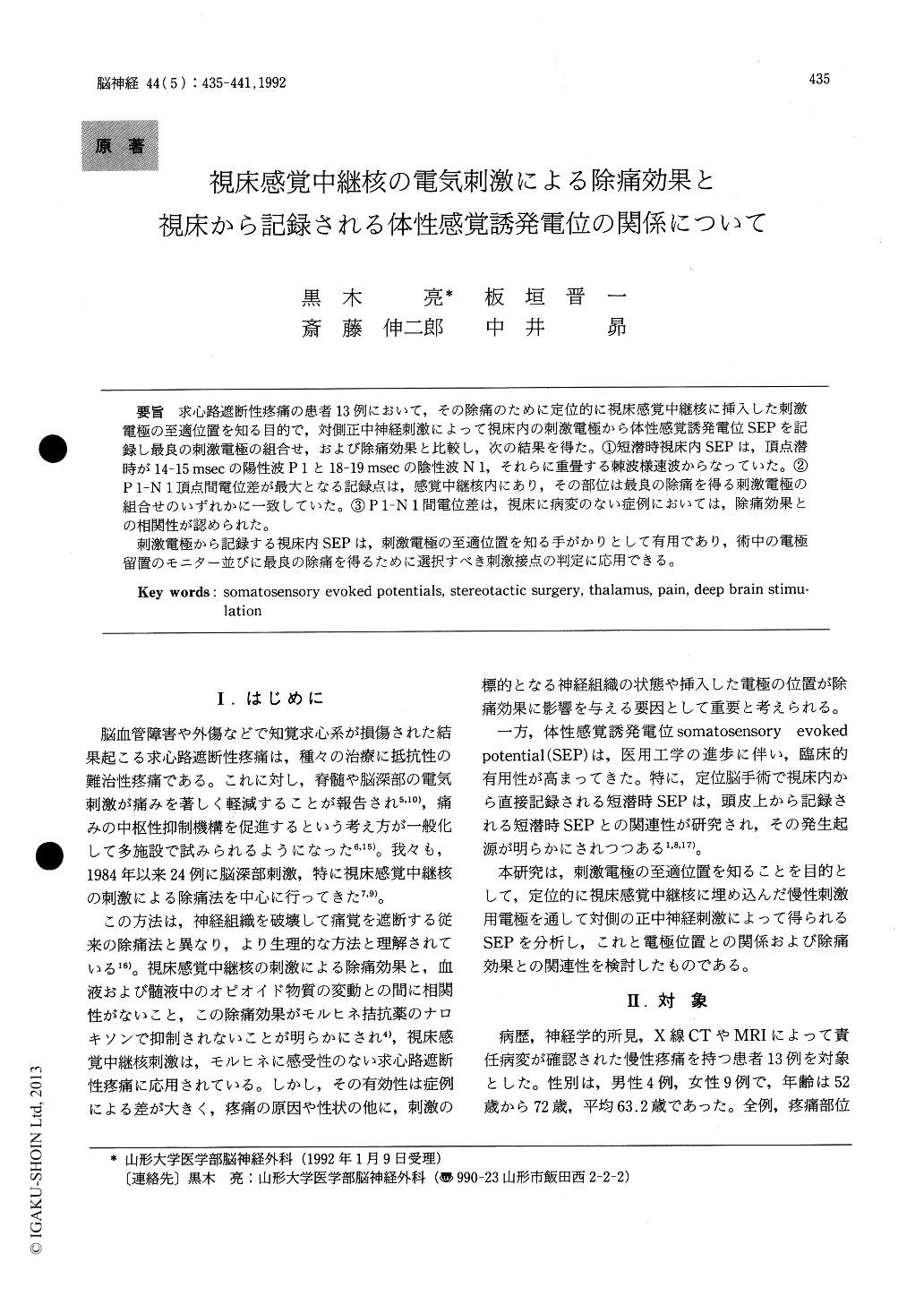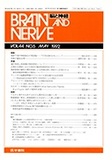Japanese
English
- 有料閲覧
- Abstract 文献概要
- 1ページ目 Look Inside
求心路遮断性疹痛の患者13例において,その除痛のために定位的に視床感覚中継核に挿入した刺激電極の至適位置を知る目的で,対側正中神経刺激によって視床内の刺激電極から体性感覚誘発電位SEPを記録し最良の刺激電極の組合せ,および除痛効果と比較し,次の結果を得た。(1)短潜時視床内SEPは,頂点潜時が14-15msecの陽性波P1と18-19msecの陰性波N1,それらに重畳する棘波様速波からなっていた。(2)P1—N1頂点間電位差が最大となる記録点は,感覚中継核内にあり,その部位は最良の除痛を得る刺激電極の組合せのいずれかに一致していた。(3)P1—N1間電位差は,視床に病変のない症例においては,除痛効果との相関性が認められた。
刺激電極から記録する視床内SEPは,刺激電極の至適位置を知る手がかりとして有用であり,術中の電極留置のモニター並びに最良の除痛を得るために選択すべき刺激接点の判定に応用できる。
Electric stimulation of the thalamic sensory relay nucleus ( Vc ) has an analgesic effect on dea-fferentation pain, however, the analgesic effect differs from patient to patient. Electrode positionand state of the substrate stimulated are considered important factors influencing the analgesic effect. In order to determine the best position for the stimu-lating electrodes, we recorded somatosensory evo-ked potentials (SEPs) from stimulating electrodes implanted in the Vc and compared thalamic SEPs with the analgesic effect of Vc stimulation.
The subjects were thirteen patients with deafferentation pain, four patients with thalamic lesions, seven patients with suprathalamic lesions and two patients with infrathalamic lesions. We inserted the electrode array into the Vc ster-eotactically, and fixed it so that stimulation-induced paresthesia would cover the painful frea. The electrode array consisted of the four contact points of four electrodes spaced at 2 mm intervals within 10 mm from the tip. Using bipolar combinations of the four electrodes (twelve combinations in all), we stimulated the Vc for about half an hour with each combination. We then rated the degree (%) of analgesia as 100% when pain disappeared and 0% when there was no change. Thalamic SEPs elicited after stimulation of the contralateral median nerve were recorded from all four contact points simulta-neously. The latencies, amplitudes and recorded positions of large early positive components (P1) followed by large negative components (N1) with latencies between 10 and 20 msec were then anal-yzed and compared with the best electrode combina-tion for optimal pain relief and with the degree of analgesia.
The results were as follows : 1. The short-latency thalamic SEPS were composed of P1 (onset and peak latencies of 11-12 msec and 14-15 msec, respectively) , followed by N1 (peak latency of 18-19 msec), superimposed with the spiky, fast wave-lets. 2. Comparison of individual SEPs recorded from the four contact points showed the electrode with the maximum peak - to - peak amplitude between P1 and N1 (Emax) lying within the Vc. 3. Emax was one of the electrodes selected as the best bipolar combination for optimal analgesic effect. 4. In the cases of extrathalamic lesions, the P1-N1 amplitude of Emax was correlated with the degree of analgesia.
Evaluation of the P1-N1 amplitude of thalamic SEPs is useful in determining the correct position for the stimulating electrodes. We can apply this method to monitoring electrode position during stereotactic surgery and to selecting optimal elec-trode combinations.

Copyright © 1992, Igaku-Shoin Ltd. All rights reserved.


